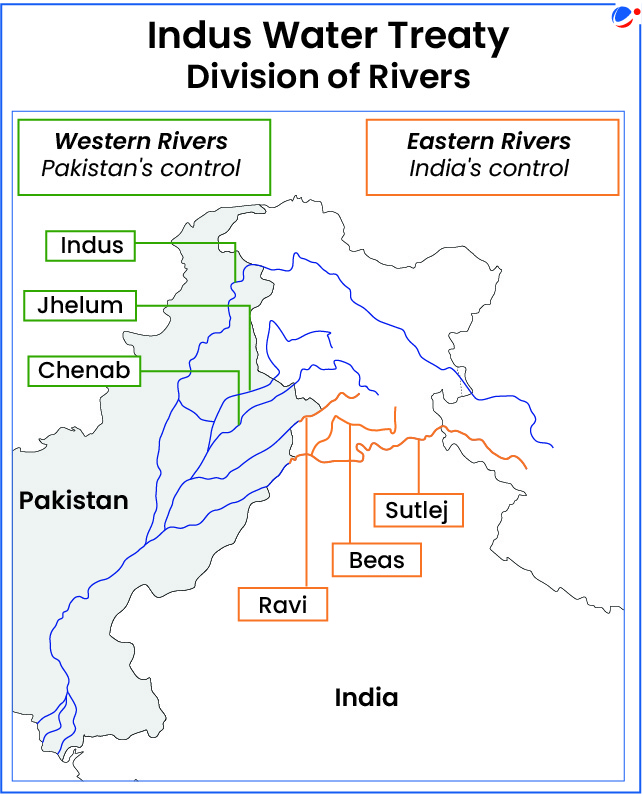Why in the News?
India announced the Indus Waters Treaty (IWT) of 1960 with Pakistan will be held 'in abeyance' with immediate effect, until Pakistan stops its support for cross-border terrorism, after recent terror attack.
More on the news
- The term 'abeyance' refers to a state of temporary disuse or suspension, but it is not a legally recognized concept under international treaty law.
- Neither IWT nor the Vienna Convention on the Law of Treaties, 1969 (VLCT) provides 'abeyance' as a basis for halting or suspending treaty obligations.
- The Vienna Convention on the Law of Treaties (VCLT) is the leading international Convention on treaties, which codifies the customary laws governing how states approach agreements, and is therefore commonly referred to as 'the treaty on treaties'.
- The IWT does not have a provision allowing for unilateral suspension.
- Article XII (4) of the IWT states the treaty "shall continue in force until terminated by a duly ratified treaty concluded for that purpose.
About the Indus Waters Treaty

- Origin: Signed in 1960 between India and Pakistan with the help of the World Bank, which is also a signatory.
- Objective: To determine the distribution of the waters of the Indus and its tributaries between India and Pakistan.
- Division of water:
- Eastern Rivers: (Ravi, Beas, and Sutlej) for India's unrestricted use.
- Western Rivers: (Indus, Jhelum, and Chenab) are allocated to Pakistan but India allowed for specific non-consumptive uses like navigation, flood protection or flood control, Domestic use, Agricultural use, Generation of hydro-electric power etc.
- According to Article III (1) of the Treaty, "India is under obligation to let flow" waters of the Western Rivers to Pakistan.
- Exchange of Data: IWT provides for data exchange with respect to the flow in, and utilization of the waters of, the Rivers regularly between the Parties.
- Dispute Resolution: IWT provides 3 Step Dispute Resolution Mechanism viz.
- Step 1: Permanent Indus Commission (PIC): Disputes are first decided at the level of the Indus Commissioners.
- The treaty required the creation of a PIC, with a commissioner from each country for communication.
- PIC is mandated to meet regularly at least once a year, alternately in India and Pakistan.
- Step 2: Neutral Expert: Appointed by World Bank and involves rendering a binding decision.
- Step 3: Court of Arbitration (CoA): If a neutral expert fails, the dispute goes to CoA. It is a generally seven-member ad-hoc arbitral tribunal, determines its procedures and decisions by majority vote.
Implications of the suspension of the Indus Waters Treaty | |
On India | On Pakistan |
|
|
Other issues with IWT
- Pakistan's objections to Indian dams: Kishanganga (Jhelum) and Ratle (Chenab) dams are objected by Pakistan.
- Not following dispute resolution mechanism: Pakistan on India's Kishanganga Hydroelectric Project bypassed the Neutral Expert mechanism and proceeded directly to arbitration at the Permanent Court of Arbitration (PCA) in The Hague.
- It violates the treaty's dispute resolution framework, which mandates a sequential escalation from technical mediation to legal arbitration.
- Biodiversity Impact: Shahpurkandi (Ravi), Ujh (Ravi) projects can alter the flow of Ravi, affecting Indus River dolphins and their habitat.
- Climate Change: The Standing Committee on Water Resources in 2021 in India has urged to renegotiate IWT with Pakistan to factor in the impact of climate change and pollution on the Indus River.
- State-sponsored terrorism: In 2016, after a terrorist attack in Kashmir, India warned that "water and blood cannot flow together".
- No regular data sharing as planned in the treaty: The flow data sharing is significantly important to understand the dynamics of the river basin in totality.
International principles on international water sharing
|
Conclusion
India's use of the term 'abeyance' is not about rejecting its international duties. Instead, it's a strategic message, i.e. treaty agreements must consider real-world politics, and they can only last if all sides stay credible and do not harm India's interests.



